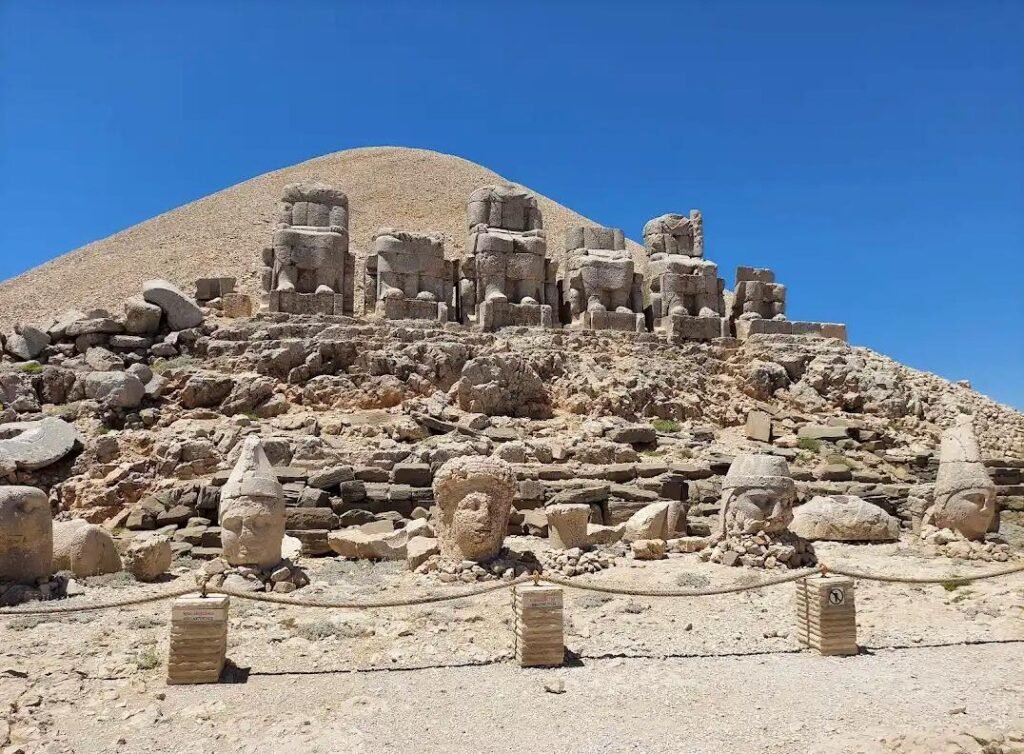Description
Discover the Majesty of Mount Nemrut: Statues and Sunrise
Nestled in southeastern Turkey, Mount Nemrut stands as a mesmerizing testament to history, culture, and natural beauty. Located in Gülveren, near Karadut in the Kahta district of Adıyaman province, this UNESCO World Heritage site draws travelers from around the globe, eager to witness its monumental statues and breathtaking sunrises. The journey to Mount Nemrut is an experience that combines the allure of ancient civilizations with the splendor of untouched landscapes.
The Historical Significance of Mount Nemrut
Mount Nemrut (Nemrut Dağı) is most renowned for its colossal statues, which date back to the 1st century BCE. These statues are remnants of the ancient Commagene Kingdom, established by King Antiochus I Theos. A ruler with grand ambitions, Antiochus sought to create a legacy that blended the cultural and religious traditions of both the East and the West. The result was a majestic funerary sanctuary atop Mount Nemrut.
At an elevation of over 2,100 meters (6,900 feet), the site features a sprawling tumulus of crushed rock, believed to be the burial mound of King Antiochus himself. Surrounding this tumulus are terraces adorned with massive limestone statues, each standing between 8 and 10 meters (26 to 33 feet) tall. These statues depict various deities, including Zeus, Apollo, Hercules, and Tyche, alongside Antiochus and a pair of guardian eagles and lions. The intricate craftsmanship and the sheer scale of these sculptures evoke a sense of awe, reflecting the king’s aspiration to achieve divine immortality.
The Enigmatic Statues
The statues of Mount Nemrut are not only remarkable for their size but also for their artistic detail. Despite centuries of exposure to harsh weather conditions, they retain much of their original splendor. The heads of the statues have detached from their bodies, likely due to seismic activity, and now rest on the ground, adding an enigmatic charm to the site.
Each statue carries symbolic meaning. For instance, the depiction of Antiochus seated among the gods signifies his claim of divine ancestry and his vision of a syncretic world. The inclusion of both Greek and Persian deities underscores the fusion of cultures that defined the Commagene Kingdom. Meanwhile, the lion statue is adorned with an astronomical relief, which some scholars interpret as a celestial map, further emphasizing the king’s fascination with the cosmos.
Sunrise: A Magical Experience
While the statues themselves are reason enough to visit Mount Nemrut, the experience is elevated to new heights by witnessing the sunrise from this ancient sanctuary. The vantage point offers a panoramic view of the surrounding landscape, where the Taurus Mountains meet the Euphrates River basin. As the first rays of sunlight illuminate the statues, they cast dramatic shadows and accentuate the intricate details of the carvings. The interplay of light and shadow creates a surreal atmosphere, making it a moment of profound beauty and reflection.
Travelers often begin their ascent in the early hours, braving the chilly pre-dawn temperatures to reach the summit in time. The hike, though challenging, is well worth the effort. The tranquil silence of the morning, broken only by the whispers of the wind, enhances the spiritual essence of the site. As the sun slowly rises, painting the sky in hues of gold, pink, and orange, visitors are treated to a spectacle that feels almost otherworldly.
Getting to Mount Nemrut
Mount Nemrut is accessible via several routes, with the most common starting points being the towns of Kahta and Adıyaman. The site is approximately 90 kilometers (56 miles) from Adıyaman and can be reached by car or guided tour. Many travelers opt to stay overnight in the nearby village of Karadut, which offers a range of accommodations, from budget-friendly guesthouses to more comfortable lodges.
For those seeking a more adventurous approach, a hike from the base to the summit can be an exhilarating way to immerse oneself in the natural beauty of the region. However, visitors should be prepared for steep inclines and fluctuating temperatures, especially during the early morning hours.
Practical Tips for Visitors
- Timing is Everything: The best times to visit Mount Nemrut are during the spring (April to June) and autumn (September to October) months when the weather is mild and the skies are clear. Summer can be scorching, while winter snow often makes the site inaccessible.
- Dress in Layers: Temperatures can vary significantly between the base and the summit, particularly at sunrise. Wear layers to stay warm during the ascent and peel them off as the day warms up.
- Bring a Flashlight: If you plan to catch the sunrise, a flashlight or headlamp is essential for navigating the path in the dark.
- Stay Hydrated: Carry enough water for the hike, as there are no facilities at the summit.
- Respect the Heritage: Avoid climbing or touching the statues to preserve their integrity for future generations.
Beyond Mount Nemrut
While Mount Nemrut is undoubtedly the highlight of the region, the surrounding area offers additional attractions worth exploring. The ancient city of Arsameia, the Severan Bridge (Cendere Köprüsü), and the Karakuş Tumulus are all located within a short distance and provide further insights into the rich history of the Commagene Kingdom.
Conclusion
Mount Nemrut is more than just a historical site; it is a destination that stirs the soul and ignites the imagination. Whether you are drawn by the allure of ancient statues, the promise of a glorious sunrise, or the chance to walk in the footsteps of history, this remarkable mountain offers an experience like no other. As you stand atop its summit, gazing at the timeless statues and the vast expanse below, you will understand why Mount Nemrut is considered one of Turkey’s most treasured gems. So pack your bags, lace up your hiking boots, and prepare to embark on a journey that will leave you with memories to cherish for a lifetime.
Location
-
Gülveren, Nemrut Dağı Yolu, 02000 Karadut/Kâhta/Adıyaman





